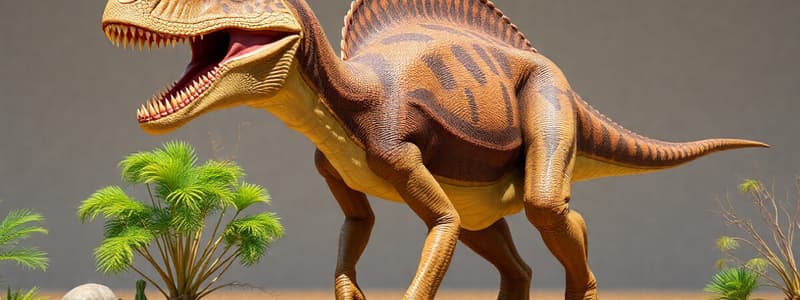Podcast
Questions and Answers
Australovenator Wintonensis was discovered in 2006 and is a type of sauropod.
Australovenator Wintonensis was discovered in 2006 and is a type of sauropod.
False (B)
Diamantinasaurus Matildae is classified as a member of the Oviraptorosauria group.
Diamantinasaurus Matildae is classified as a member of the Oviraptorosauria group.
True (A)
Minmi Paravertebra was found in rocks dating back to the Late Cretaceous period.
Minmi Paravertebra was found in rocks dating back to the Late Cretaceous period.
False (B)
The estimated length of Australovenator Wintonensis is around 5-6 meters.
The estimated length of Australovenator Wintonensis is around 5-6 meters.
Diamantinasaurus Matildae is considered a small titanosaur, reaching lengths of 5-6 meters.
Diamantinasaurus Matildae is considered a small titanosaur, reaching lengths of 5-6 meters.
Minmi Paravertebra is theorized to have been a fast runner due to its long legs.
Minmi Paravertebra is theorized to have been a fast runner due to its long legs.
The forearms of Australovenator Wintonensis were not capable of a wide range of movement.
The forearms of Australovenator Wintonensis were not capable of a wide range of movement.
The distinctive bony rods along the spine of Minmi Paravertebra were likely for muscle attachment.
The distinctive bony rods along the spine of Minmi Paravertebra were likely for muscle attachment.
Flashcards
Australovenator Wintonensis
Australovenator Wintonensis
A theropod dinosaur, likely a predator, found in Queensland, Australia.
Megaraptoridae
Megaraptoridae
A group of theropod dinosaurs, with potentially powerful hands/feet for hunting.
Diamantinasaurus Matildae
Diamantinasaurus Matildae
A titanosaur sauropod, a large plant-eating dinosaur.
Titanosaurs
Titanosaurs
Signup and view all the flashcards
Minmi Paravertebra
Minmi Paravertebra
Signup and view all the flashcards
Ankylosaur
Ankylosaur
Signup and view all the flashcards
Early Cretaceous
Early Cretaceous
Signup and view all the flashcards
Insular Dwarfism
Insular Dwarfism
Signup and view all the flashcards
Study Notes
Australovenator Wintonensis
- Discovered in 2006 during an expedition in Queensland
- Remains were relatively complete for an Australian theropod, including lower jaw, teeth, ribs, hip bones, arms, hands, legs, and feet
- Classification has been debated:
- Initially classified as an Allosauroid
- Later classified as a member of the Megaraptoridae, then within the Megaraptorans
- Further studies also linked it to Tyrannosauroids and basal Allosauroids
- Estimated to have been 5-6 meters in length
- Described as the “cheetah of its time”
- Possessed relatively small teeth but powerful arms
- Forearms capable of a wide range of movement, fingers could hyper-extend, suggesting prey was dispatched using hands and feet
Diamantinasaurus Matildae
- A titanosaurian sauropod discovered alongside Australovenator
- Fossils include hindlimbs, ribs, hip bones, vertebrae, scapula, and skull fragments
- Smaller titanosaurs, reaching lengths of 15-16 meters
- Likely possessed osteoderms embedded in the skin, although no direct evidence exists
- Classification has been revised over time:
- Initially considered a Lithostrotian titanosaur, known for osteoderms
- Later analyses placed it within Saltasaurinae and Oviraptorosauria titanosaur groups
- Found in temperate to subtropical river floodplain environment during the Late Cretaceous
Minmi Paravertebra
- A small Australian ankylosaur, initially considered the only ankylosaur found in the Southern Hemisphere
- Discovered in rocks dating back to the Early Cretaceous (119-113 million years ago)
- Original find was a partial skeleton, a more complete specimen found in 1989 preserved a skull, body armor, and limbs
- Smaller than most relatives, reaching about 3 meters in length
- Small size potentially attributed to insular dwarfism, although evidence is limited
- Distinctive bony rods along the spine were likely for muscle attachment
- The rods have been proposed to support the back muscles and/or be attached to armor plates for threat displays
- Due to its lack of armor and long legs, Mimmi is theorized to have been a fast runner for predator escape
Studying That Suits You
Use AI to generate personalized quizzes and flashcards to suit your learning preferences.
